In the first section of Event Information, you can fill out your event’s contact and location information and upload your logo. We recommend uploading a square logo of 250 x 250 pixels to ensure that your logo—not ZAPP’s—displays when your event page is shared on social media sites. If you need to upload a rectangular logo, we recommend dimensions of 300 x 166 pixels.
THE EVENT EDITOR: BUILDING YOUR APPLICATION
EVENT INFORMATION
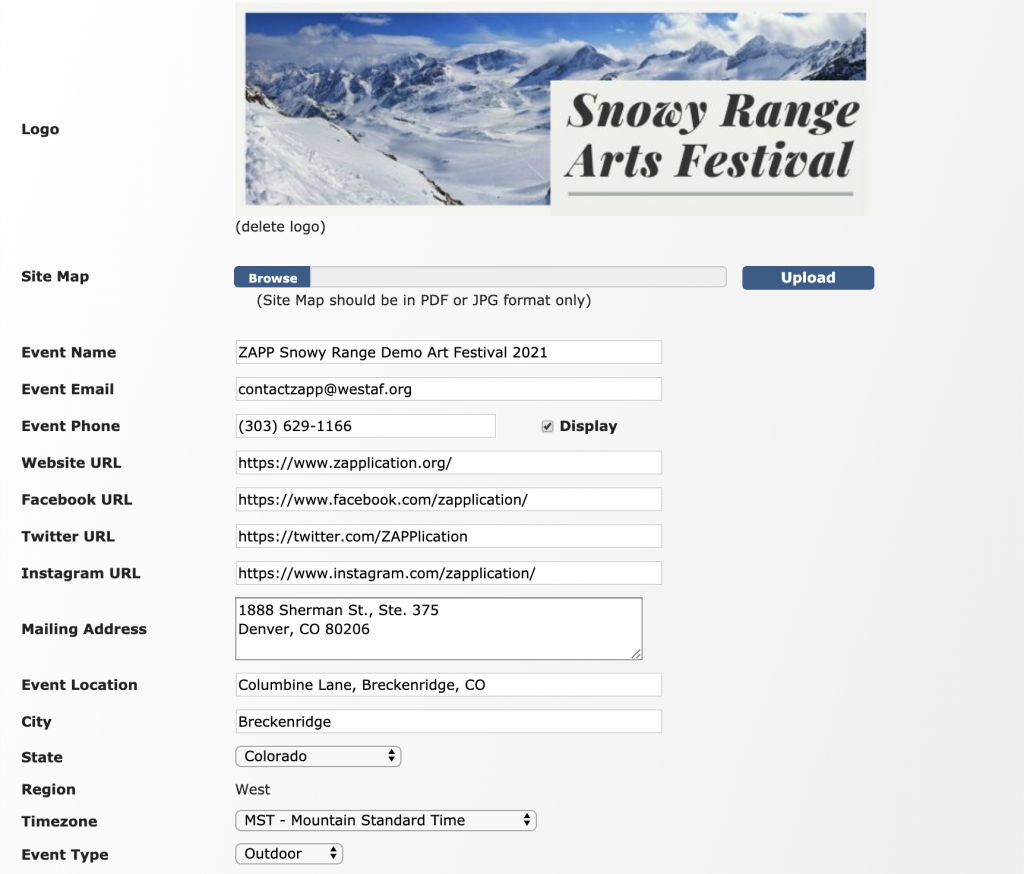

The second section of Event Information allows you to list out all applicable dates for your event:
- Accept Applications: The date when your application will begin to accept submissions. This date is public to artists.
- Application Deadline: Your application will close at 11:59.59 p.m. on this date based on the time zone you set in your event information. This date is public to artists.
- Jury Start and Jury End: The dates when you conduct your jury. These dates do not display publicly to artists, but the ZAPP team may use them to send you resources and check-ins.
- Notification Date: This is the date when you plan to send jury results and notify artists of their application status (Invited, Not Invited, or Waitlist). To make this date visible to artists, click the checkbox next to Display. Entering a date into this field is recommended but not required.
- Accept Invitation & Purchase Deadline: The deadline for artists to accept their invitations and purchase booth products (if you are selling them on ZAPP). This date will appear to artists in their ZAPP Shop.
- Event Start and Event End: The dates of your event. These dates are public to artists and cannot be changed without notifying all applicants.*
- Juried vs Not Juried: Whether or not your event is juried or not juried. Artists will be able to filter by juried or non-juried events on the Events List, Apply to Shows, and Events Calendar pages.
*If you need to change your event dates, notify the ZAPP team at zapphelp@westaf.org immediately.
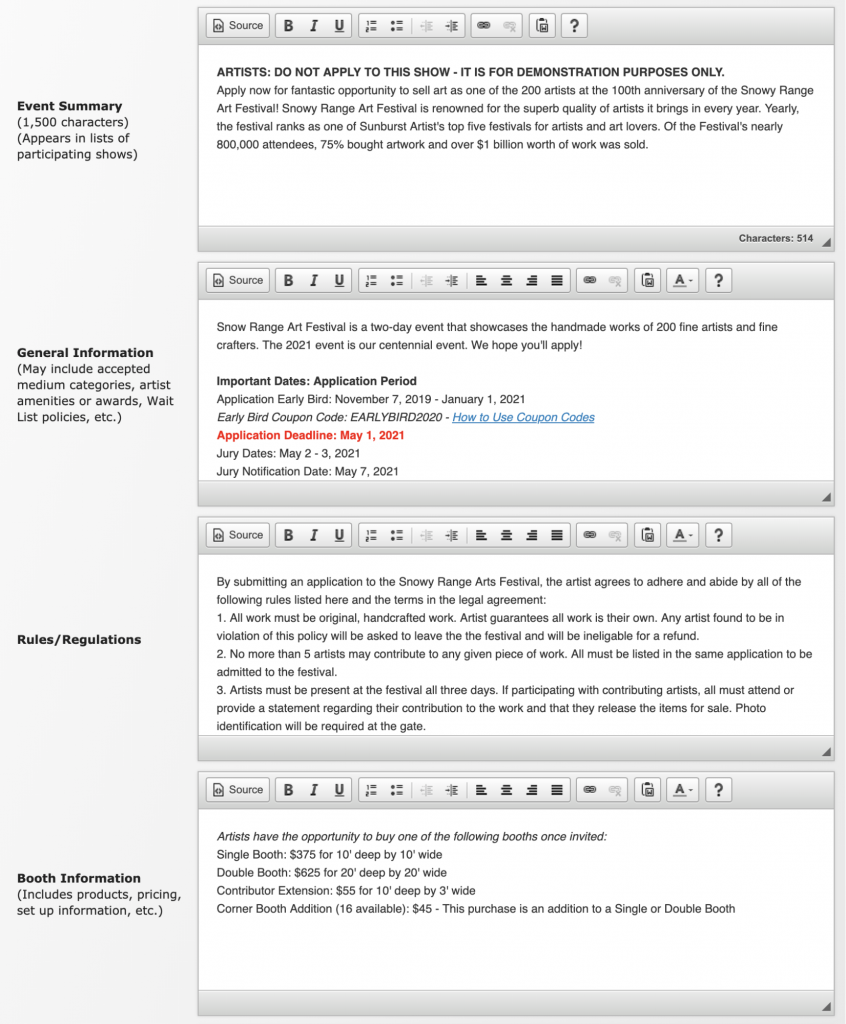
The text boxes located below your event dates make up your prospectus. Your prospectus is public to any user on zapplication.org.
- Event Summary: This section has a 1,500 character limit and is intended to be the promotional blurb for your event. The text from this section is pulled into the Event Cards that load at the bottom of the Events Calendar and into our Weekly Wednesday e-blast (your event will be included in two e-blasts—the first will be sent out shortly after you open your application and the second will be sent out on a date closer to your deadline).
- General Information: This section has no character limit and can include information on the medium categories you allow, artist amenities, early-bird policies, and FAQs.
- Rules/Regulations: This section has no character limit and is for rules and policies for your application and jurying process as well as participation in the event (think refund policies, buy/sell policies, booth-sharing rules, cancellation policies, etc.).
- Booth Information: This section has no character limit and can be used to provide artists with information about your booth spaces, including cost, size, and availability.

The Legal Agreement is the only field that cannot be edited once your event is published on ZAPP. You can enter your event contract or legal terms; artists are required to accept your legal agreement before they can apply to your event.

In the last section of your Event Information, you’ll see four settings:
- Allow Artists to Archive: The ZAPP team manages this setting, which allows artists to archive applications to your event that are no longer relevant (e.g. an application for an artist who is not invited to the event).
- Show Booth Assignments to Artists: After you assign booth numbers to artists, you can make their assignments visible to them when they log in to ZAPP by activating this feature. They will not be able to see other artists’ booth assignments.
- Show Waitlist Numbers to Artists: After you assign waitlist numbers to artists on your waitlist, you can make those numbers visible to them by activating this feature. They will not be able to see other artists’ waitlist numbers.
- Display Slideshow Images: This affects your administrator slideshow by displaying either a single image at a time or a grouping of thumbnail images per applicant. The admin slideshow is found on the Event Management page.
Remember to save your work frequently! ZAPP does not autosave and users are logged out of the site after 30 minutes of inactivity. To preview your prospectus, click on the “Preview” button at the bottom of the page.
JURY DETAILS
You may want to include the following information:
- Jury Method: How will images be viewed by your jury?
- Order: In what order will artists be juried?
- Scoring: How will your jury score applicants?
- Jurors: How many jurors will score applications?
- Jury Organization: How will the jury operate?
- Applications: How many applications do you receive typically?
- Invited: How many artists are typically invited to participate?
- Exempt: How many artists are re-invited without being juried?
- Observation: Is your jury process open to observers?
APPLICATION EDITOR

Create medium categories in the first section of the Application Editor. Medium categories are required and can be completely customized for your event. If you are accepting all media, you can create a field labeled “All Medium Categories.”
Once artists have submitted an application in a medium category, you will not be able to delete that category
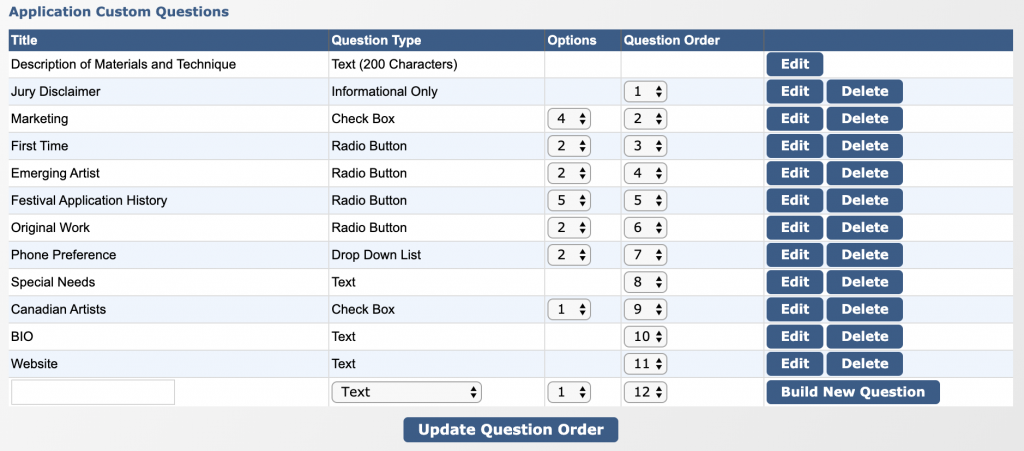
The next section, Application Custom Questions, is where you can create custom questions for artists to complete as part of their application to your event. The Description of Materials and Technique question is required for every event. Artists can answer this question by inserting pre-saved statements from their accounts for convenience. You can change the character limit for this question.
Building a Custom Question
Within the Application Editor, click “Build New Question” to open the custom question builder. From the Question Type drop down, select your question type. You have the ability to create questions using five different question types:
- Text: Applicants will answer in a freeform text box. You can set a character limit for their answers.
- Check Box: Multi-select question that allows applicants to select one or more options from a list.
- Radio Button: A single-select question that allows applicants to pick a single answer—this is particularly useful for yes/no questions.
- Drop-down List: A single-select question in which applicants select an answer from a drop-down list of potential answers.
- Informational Only: Instructional text that is useful for reiterating certain policies or application instructions. Applicants cannot answer this question.
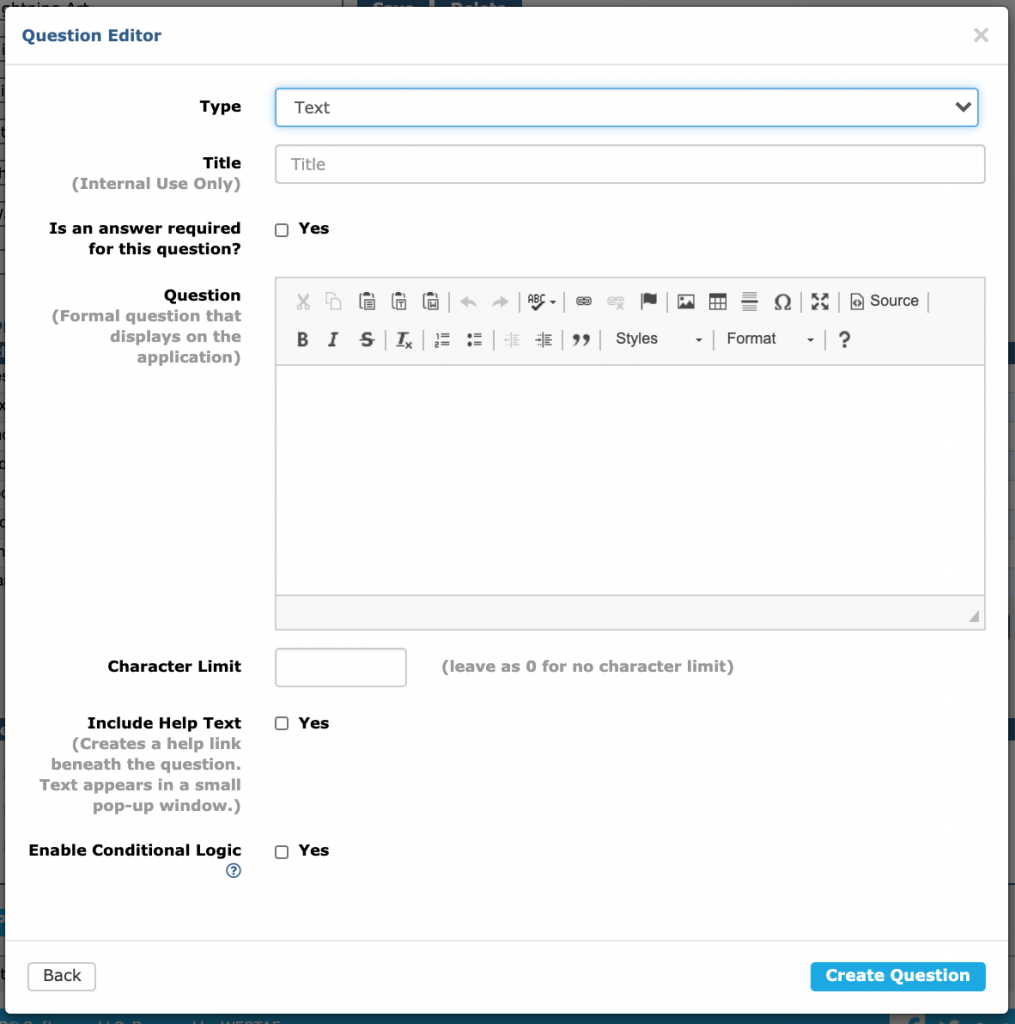
Once you select a question type, the following sections will load (depending on the question type selected):
- Title: This title is just for internal use. It is not the question artists will see.
- Is an answer required for this question?: This field controls whether or not artists must submit their answer before completing their application.
- Question: This is the field where you enter the question. It will display on the application.
- Character Limit: Only available for text question types.
- Options: Only available for multi-select question types
- Include Help Text: Checking this option will display a text box for you to add additional information about the question. Information listed in this box will be listed under a blue “?” icon to the left of the question. Applicants can read this information if they have any follow-up questions about your application.
- Conditional Logic: Administrators can now use conditional logic to create questions that will only appear if a specific answer is selected for a previous question. For example, if you have a question that is only applicable for award winners, you can first add a question that reads “Are you an award winner from 2020?” You can then create the question you wish to ask of applicants who answered “Yes” to that question, such as “What was the award you won?”. Within that second question, you can enable conditional logic to ensure the question will only be asked if the answer to the first question was “Yes.”
Once you have entered all applicable information, just click “Create Question” to add it to your application!

Back on your Application Editor, the last section allows you to choose the number of images artists are required to submit.
- Number of Images: This is the number of artwork images artists are required to submit.
- Booth Shot: Activating this field will require artists to submit a booth shot in addition to the required number of artwork images.
- Display: This field impacts how jurors will view images within your jury. If you are collecting a total of five images or less, we recommend choosing that same number so that all of the images display on one row. If you are collecting six images or more, aim for having two rows (so, for six total images, three images per row).
Remember to save your application frequently! We also recommend previewing your application once you have built out your custom questions so you can ensure it all looks good.
PRODUCT EDITOR
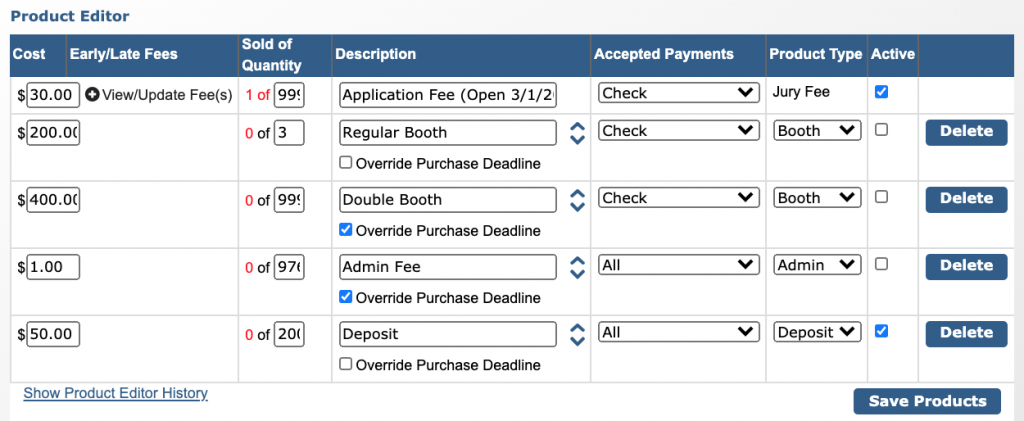
In the Product Editor, you can create seven separate product types in addition to the required Jury Fee that will be pre loaded into your editor. Products must be active for applicants to see and purchase them.
- Jury Fee: The Jury Fee is a required product that artists must purchase in order to submit an application. If you are not charging an application or jury fee, you can set this field to zero and artists will be prompted to check out with the free product. You can also create an Early Bird or Late Fee in addition to your Jury Fee and set them to activate or deactivate on specific dates.
- Admin: This fee can be seen and purchased by artists in any status and will not change their application status.
- Booth: Only artists in the Exempt from Jury, Invited, Accepted, and Confirmed statuses can purchase this product type. Purchasing this product moves artists into the Confirmed status (if they pay by check they will first move to Awaiting Payment by Check).
- Canopy: This product type can be purchased by artists in the Exempt from Jury, Invited, Accepted, and Confirmed statuses. It will not change their application status.
- Deposit: This product type allows administrators to collect a portion of a booth fee from artists without their application status changing to Confirmed. Purchasing this product will add a “DEPOSIT” tag to the application.
- Electric: This product type can be purchased by artists in the Exempt from Jury, Invited, Accepted, and Confirmed statuses. It will not change their application status.
- Other: This product type can be purchased by any artist after their application has been received. Purchasing this product will not change their application status.
- Tent: This product type can be purchased by artists in the Exempt from Jury, Invited, Accepted, and Confirmed statuses. It will not change their application status.
The Product Editor also features a few different customizations for event administrators:
- Sold of Quantity: The number of products available for purchase. Once this number has been met, artists will see the words SOLD OUT and will not be able to add the product to their cart.
- Override Purchase Deadline: Checking this box makes the product available for purchase until your event ends and will not be restricted by your “Accept Invitation and Purchase Deadline.” Artists will see the last day of your event as the purchase deadline for this product.
- Accepted Payments: Event administrators can choose to accept all payment types (credit card, PayPal, and checks) or limit the payment options to either Credit and Paypal or Check.
Change the order in which your products appear to artists by using the arrows to rearrange your products. Add a new product by completing all the blank fields under “New Product” at the bottom of the page. Save changes by clicking the “Save Products” button.
PUBLISH YOUR APPLICATION
Ready to publish your application? Submit a ticket and we will review your application to ensure artists are able to apply without issue before publishing it on ZAPP! While we can publish your event details at any time, artists will not be able to apply until your Accept Applications date. Once your event is listed on ZAPP, we will send you a link so you can publicize your application.
